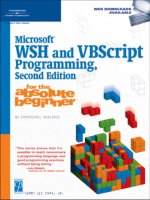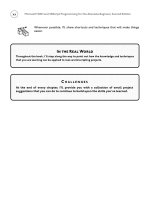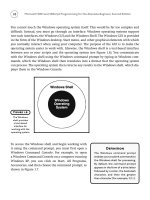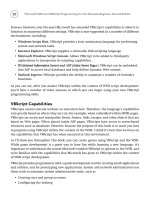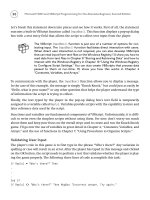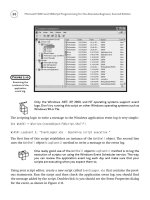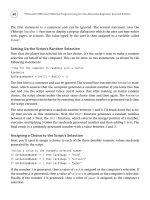Microsoft WSH and VBScript Programming for the Absolute Beginner Part 47 pps
Bạn đang xem bản rút gọn của tài liệu. Xem và tải ngay bản đầy đủ của tài liệu tại đây (145.2 KB, 10 trang )
440
‘use the objWshNetwork object’s MapNetworkDrive() method to map to drive
objWshNet.MapNetworkDrive DriveLetter, NetworkPath
End Sub
Disconnecting Mapped Drives
You can use the WshNetwork objects’ RemoveNetworkDrive() method to disconnect a mapped
drive when it’s no longer needed. For example, you might want to do this at the end of the
script that created the drive mapping, after it has completed its assigned task. The syntax of
the
RemoveNetworkDrive() method is as follows:
WshNetwork.RemoveNetworkDrive letter, [kill], [persistent]
Letter
is the drive that has been assigned to the mapped drive. Kill is an optional setting
with a value of either
True or False. Setting it to True disconnects a mapped drive even if it
is currently in use.
Persistent is also optional. Set it to True to disconnect a permanently
mapped drive.
The following VBScript demonstrates how to disconnect the network drive that was mapped
by the previous script:
‘*************************************************************************
‘Script Name: DriveBuster.vbs
‘Author: Jerry Ford
‘Created: 12/07/02
‘Description: This script demonstrates how to add logic to VBScripts in
‘order to terminate a network drive mapping.
‘*************************************************************************
‘Initialization Section
Option Explicit
On Error Resume Next
Dim objWshNet
‘Instantiate the objWshNetwork object
Set objWshNet = WScript.CreateObject(“WScript.Network”)
Microsoft WSH and VBScript Programming for the Absolute Beginner, Second Edition
‘Main Processing Section
‘Call procedure that deletes network drive connections, passing it the
‘the drive letter to be removed
MapNetworkDrive “z:”
WScript.Quit() ‘Terminate script execution
‘Procedure Section
‘This subroutine disconnects the specified network drive connection
Sub MapNetworkDrive(DriveLetter)
‘Use the objWshNetwork object’s RemoteNetworkDrive() method to disconnect
‘the specified network drive
objWshNet.RemoveNetworkDrive DriveLetter
End Sub
Printer Administration
Printer administration involves many tasks. One task is setting up network printer connections.
Other tasks include managing print jobs and physically managing the printer, including
refilling its paper, ink, ribbon, or toner supply. Another task includes removing printer
connections when they are no longer needed. The next two sections demonstrate how to use
VBScript and the WSH to set up and disconnect network printer connections.
Connecting to a Network Printer
To create a connection to a network printer, you need to use the WshNetwork object’s AddWindows-
PrinterConnection()
method. This method has two different types of syntax, depending on
the operating system on which the script is executed.
The syntax for the
AddWindowsPrinterConnection() method when used on a computer run-
ning Windows NT, 2000, or XP is
WshNetwork.AddWindowsPrinterConnection(strPrinterPath)
441
Appendix A • WSH Administrative Scripting
442
The syntax for the AddWindowsPrinterConnection() method when used on a computer running
Windows 95, 98, or Me is as follows:
WshNetwork.AddWindowsPrinterConnection(strPrinterPath, strDriverName
[, strPort])
StrPrinterPath
is the UNC path and name for the network printer. StrDriverName is the
name of the appropriate printer software driver, and
StrPort is an optional port assignment
for the printer connection.
The following VBScript demonstrates how to set up a network printer connection:
‘*************************************************************************
‘Script Name: PrinterMapper.vbs
‘Author: Jerry Ford
‘Created: 12/07/02
‘Description: This script demonstrates how to use a VBScript to set up a
‘connection to a network printer.
‘*************************************************************************
‘Initialization Section
Option Explicit
Dim objWshNet
‘Instantiate the objWshNetwork object
Set objWshNet = WScript.CreateObject(“WScript.Network”)
‘Main Processing Section
‘Call the procedure that creates network printer connections passing
‘it a port number and the UNC pathname of the network printer
SetupNetworkPrinterConnection “\\ICS_Server\CanonPrinter”
WScript.Quit() ‘Terminate script execution
Microsoft WSH and VBScript Programming for the Absolute Beginner, Second Edition
‘Procedure Section
Sub SetupNetworkPrinterConnection(NetworkPath)
‘Use the objWshNetwork object’s AddWindowsPrinterConnection() method
‘to connect to the network printer
objWshNet.AddWindowsPrinterConnection NetworkPath
End Sub
Disconnecting from a Network Printer
As with network drives, removing a printer connection is a little easier to do than connect-
ing it initially. Printer connections need to be removed for a number of reasons. For example,
every printer eventually breaks and must be replaced. Sometimes people move from one loca-
tion to another, necessitating changes to printer connections. By scripting the setup and
removal of printer connections, you can automate this process. To remove a network printer
connection, you need to use the
WshNetwork object’s RemovePrinterConnection() method:
WshNetwork.RemovePrinterConnection resource, [kill], [persistent]
Resource
identifies the printer connection and may be either the connection’s assigned port
number or its UNC name and path.
Kill is an optional setting with a value of either True
or False. Setting it to True disconnects a printer connection even if it is currently in use.
Persistent is also optional. Set it to True to disconnect a permanent printer connection.
The following VBScript demonstrates how to remove the printer connection established by
the previous VBScript:
‘*************************************************************************
‘Script Name: PrinterBuster.vbs
‘Author: Jerry Ford
‘Created: 12/07/02
‘Description: This script demonstrates how to use a VBScript to disconnect
‘a network printer connection.
‘*************************************************************************
‘Initialization Section
443
Appendix A • WSH Administrative Scripting
444
Option Explicit
Dim objWshNet
‘Instantiate the objWshNetwork object
Set objWshNet = WScript.CreateObject(“WScript.Network”)
‘Main Processing Section
‘Call the procedures that disconnect network printer connections passing
‘it the UNC pathname of the network printer
SetupNetworkPrinterConnection “\\ICS_Server\CanonPrinter”
‘Terminate script execution
WScript.Quit()
‘Procedure Section
Sub SetupNetworkPrinterConnection(NetworkPath)
‘Use the objWshNetwork object’s RemovePrinterConnection() method to
‘disconnect from a network printer
objWshNet.RemovePrinterConnection NetworkPath, “True”, “True”
End Sub
Computer Administration
The term computer administration represents a very broad category of tasks. Rather than try
to list or explain them all, I’ll simply present you with two computer administration examples.
The first example demonstrates how to use VBScript and the WSH to manage Windows
services, and the second example demonstrates automated user account creation.
Managing Services
On computers running Windows NT, 2000, and XP operating systems, much of the operat-
ing system’s core functionality is provided in the form of services. These services perform
Microsoft WSH and VBScript Programming for the Absolute Beginner, Second Edition
tasks, such as managing Windows plug and play, handling the spooling of printer jobs, and
administering the execution of scheduled tasks. By starting and stopping Windows services,
you can enable and disable specific Windows functions (that is, control just what users can
and cannot do).
You can use the Windows
NET STOP and NET START commands to stop and start Windows ser-
vices. To execute these commands from within a VBScript, you can use the
WshShell object’s
Run() method, as demonstrated in the following script:
‘*************************************************************************
‘Script Name: ServiceCycler.vbs
‘Author: Jerry Ford
‘Created: 12/07/02
‘Description: This script demonstrates how to use VBScript to stop and
‘start Windows services.
‘*************************************************************************
‘Initialization Section
Option Explicit
On Error Resume Next
Dim objWshShl, strServiceToManage
‘Instantiate the WshShell object
Set objWshShl = WScript.CreateObject(“WScript.Shell”)
‘Main Processing Section
‘Prompt the user to specify the name of the service to cycle
strServiceToManage = InputBox(“What service would you like to cycle?”)
‘Call the procedure that stops a service
StopService(strServiceToManage)
445
Appendix A • WSH Administrative Scripting
446
‘Pause for 5 seconds
WScript.Sleep(15000)
‘Call the procedure that starts a service
StartService(strServiceToManage)
‘Terminate script execution
WScript.Quit()
‘Procedure Section
‘This subroutine stops a specified service
Function StopService(ServiceName)
objWshShl.Run “net stop “ & ServiceName, 0, “True”
End Function
‘This subroutine starts a specified service
Function StartService(ServiceName)
objWshShl.Run “net start “ & ServiceName, 0, “True”
End Function
User Account Administration
User administration involves many tasks, including creating, modifying, and removing user
accounts from the computer or the Windows domain to which the computer is a member.
To perform user account administration, you need to have administrative privileges within
the context that the script will execute (that is, on the computer or at the domain level).
One way to create a new user account is with the Windows
NET USER command.
You also can use the NET GROUP command to add a newly created user account
into a global domain group account or the NET LOCALGROUP command to add the
user account to a local group.
TRICK
Microsoft WSH and VBScript Programming for the Absolute Beginner, Second Edition
For example, the following VBScript uses the WshShell object’s Run() method and the NET
USER
command to create a new user account on the Windows NT, 2000, or XP computer on
which the script is executed.
‘*************************************************************************
‘Script Name: AccountCreator.vbs
‘Author: Jerry Ford
‘Created: 12/07/02
‘Description: This script demonstrates how to use VBScript to create new
‘user accounts.
‘*************************************************************************
‘Initialization Section
Option Explicit
On Error Resume Next
Dim objFsoObject, objWshShl, strNewAccts, strAcctName
‘Instantiate the FileSystemObject object
Set objFsoObject = CreateObject(“Scripting.FileSystemObject”)
‘Instantiate the WshShell object
Set objWshShl = WScript.CreateObject(“WScript.Shell”)
‘Specify the location of the file containing the new user account name
Set strNewAccts = _
objFsoObject.OpenTextFile(“c:\Temp\UserNames.txt”, 1, “True”)
‘Main Processing Section
CreateNewAccts() ‘Call the procedure that creates new user accounts
WScript.Quit() ‘Terminate script execution
447
Appendix A • WSH Administrative Scripting
448
‘Procedure Section
Sub CreateNewAccts() ‘This procedures creates new accounts
‘Create a Do While loop to process each line in the input file
Do while False = strNewAccts.AtEndOfStream
‘Each line of the file specifies a unique username
strAcctName = strNewAccts.ReadLine()
‘Create the new account
objWshShl.Run “net user “ & strAcctName & “ “ & strAcctName & _
“ /add”, 0
Loop
‘Close the input file
strNewAccts.Close
End Sub
To make the script more flexible, it has been set up to use VBScript FileSystemObject methods,
which allow it to open and retrieve a list of names from an external file called
UserNames.txt, located in the C:\Temp folder. This way, the script can be used over and over
again without any modification. All you need to do is modify the script’s input text file.
Scheduling the Execution of Administrative Scripts
Windows operating systems provide two means of scheduling script execution. The first
option is the
AT command, which is executed from the Windows command prompt. The sec-
ond option is to use the Scheduled Task Wizard, which provides a step-by-step walk-through
of the scheduling process. In addition, you can also use either of these two options to auto-
mate the execution of a single master scheduling script, from which you can programmati-
cally control the execution of other VBScripts.
The AT Command
The Windows AT command allows you to set up and manage scheduled tasks from the Windows
command prompt, which you can access from within your VBScripts using the
WshShell
object’s Run() method.
Microsoft WSH and VBScript Programming for the Absolute Beginner, Second Edition
There are two different types of syntax for the AT command. The syntax used to delete sched-
uled tasks:
at [\\computername] [[id] [/delete] | /delete [/yes]]
To view a list of currently scheduled tasks, type the AT command at the
Windows command prompt and press the Enter key.
To set the computer at which a new scheduled task is to be executed, specify the computer’s
name in place of
\\computername. Id identifies a numbered task ID assigned to every task by the
scheduler service.
/Delete performs a task deletion. /Yes is used to supply a confirmation for a
delete operation.
The syntax used to create a new scheduled task is
at [\\computer] time [/interactive] [/every:date[, ] | /next:date[, ]]
command
\\Computer
specifies the computer where the task is to be scheduled. Time specifies the time
that task is to be executed in the format of
hh:mm on a 24-hour clock. Specify /interactive to
allow the script to interact with the desktop and the logged on user. /
Every:date[, ] spec-
ifies the task’s schedule using specified days of the week or month. For example, dates are
specified as M, T, W, Th, F, S, Su, and days of the month are specified as
1 - 31. /Next:
date[, ]
sets the tasks to run on the next occurrence of a specified day or date. Finally,
command specifies the name of the application or script to be scheduled.
The following VBScript demonstrates how to use the Windows
AT command to set up sched-
uled tasks for three VBScripts:
‘*************************************************************************
‘Script Name: AtScheduler.vbs
‘Author: Jerry Ford
‘Created: 12/07/02
‘Description: This script demonstrates how to use the Windows AT command
‘within a VBScript to schedule the execution of other scripts.
‘*************************************************************************
‘Initialization Section
Option Explicit
TRICK
449
Appendix A • WSH Administrative Scripting

